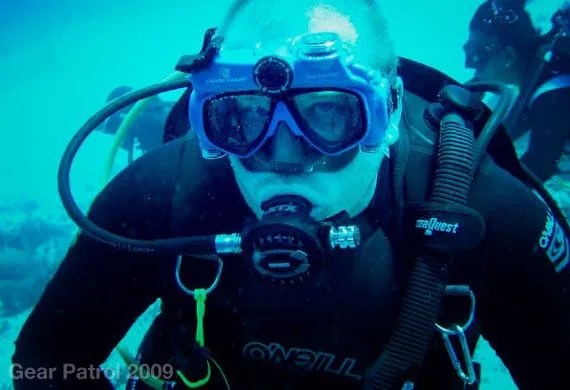
It’s almost impossible to describe what it’s like to scuba dive to someone who hasn’t done it. Since Jacques Cousteau’s epic film, The Silent World in 1953, divers have tried to bring back a little bit of the experience on film and megabyte, still and video. There have been any number of dedicated underwater cameras and housings, all with their own merits. The flaw they all share is that they occupy your hands and your attention while you are using them. So when a Liquid Image Scuba Series HD camera mask arrived at GP, we were excited. We’ve seen helmet cams, surfboard cams and dashboard cams. Why not a scuba mask cam?
Liquid Image started out making cameras that were integrated into swim masks, primarily for use in the pool or while snorkeling and diving to shallow depths. This past year, they released their Scuba Series mask cam and it was a great leap forward. The camera is rated to a depth of 115 feet, deeper than most recreational divers go and well below the underwater light zone where colors are visible anyway. Liquid Image sells attachable lights but it’s recommended to use this camera on shallower, well-lit dives.
The mask comes in two sizes and, as any diver knows, good mask fit is essential. After some tweaking, I had little trouble getting the Scuba Series HD to fit my face, though it did leak a little bit throughout my dives. Because the camera and its four onboard AA batteries reside on top of the mask, it is a little bit top-heavy. Once submerged though, you don’t notice this and it feels like any other mask.

Camera controls couldn’t be simpler. A power/mode button turns the camera on and off and switches between still photo and video modes while another button fires the camera or starts and stops the video. A rubber stopper can be engaged while not diving so the power button doesn’t get pressed accidently during travel. Since the camera is operated by touch alone, a clever LED light indicator lets the user know if it is in still or video mode. The diver sees a red light at the top of the upper right lens when the camera is in still photo mode. A blue light indicates video mode. If the blue light is flashing, the camera is filming. I found the blue light hard to see in the bright blue Caribbean and had to cover the right lens with my hand to tell if I was filming or not.
Camera memory is in the form of a removable MicroSD card, which fits into a watertight compartment at the top of the camera, next to a USB port. I had a 2GB card in the camera and didn’t even make a dent in it after four dives and a lot of filming. Similarly, battery life is impressive. The four lithium AA batteries stayed strong which is more than I can say for the rechargeable battery in my Olympus which had to be charged daily. Video quality is superb. 720P hi-definition video yields crisp, colorful footage that would have made old Jacques-Yves green with envy. Still images are at a respectable 5.0 megapixel. Playback is only possible after downloading the clips to a computer so be sure to pack along your laptop if you want instant gratification.
